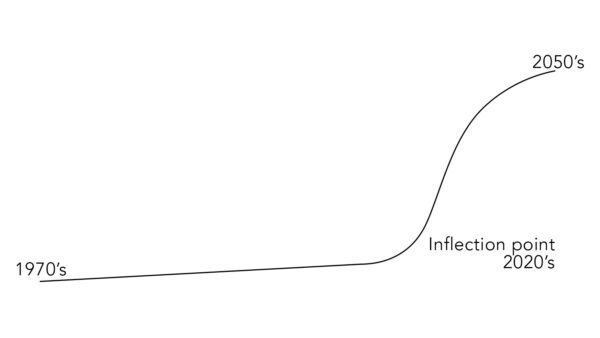
Alberta leadership must be held accountable for clinging to slow transition thinking
The global energy system is transitioning from fossil fuels (coal, oil, gas) to zero or low-carbon electricity and fuels like hydrogen. Will the transition be fast or slow? The correct answer to that question is critical to the economic future of hydrocarbon-rich Alberta. Unfortunately, the province’s political and business leaders have arrived at the wrong answer.
First, the argument for a slow transition.
All historical energy transitions have been slow. The one I’m most familiar with, the switch from steam and animal power to petroleum and the internal combustion engine a hundred years ago in Western Canadian farming, took 50 years. The technology wasn’t even ready for prime time until the 1920s. Then it took another two decades before horses disappeared from Prairie farms.
Today, the global energy system is massive, with trillions of dollars already sunk into infrastructure to extract, transport, and consume fossil fuels. No wonder 80 per cent of primary energy still comes from fossil fuels. And that proportion remains stubbornly hard to change. Systems inertia is a powerful impediment to rapid change.
“As in the past, the coming energy transitions will unfold across decades, not years,” Professor Vaclav Smil, the pre-eminent scholar on the topic, says in his 2016 book, Energy Transitions.
Smil is music to the ears of Alberta oil and gas CEOs and their supporters. He justifies their decisions to stick to their current business model. In fact, many of those leaders want to double down on the status quo by actually expanding production. The current fixation with building LNG plants on the West Coast is one example. Premier Danielle Smith and her UCP government, closely aligned with the industry, sings from the same songbook.
A common talking point in this crowd is that oil demand won’t peak until 2040 or 2050, while decline will be gradual.
But Albertans, who own the resource, after all, should ask a very important question: are transitions uniformly slow across the decades? As it happens, no.
Which leads us to the argument for a fast transition.
This transition is driven by new energy technologies. On the supply side are clean and now inexpensive renewable energies like wind and solar, increasingly combined with storage. On the demand side are new or improved “prime movers” like electric vehicles and heat pumps.
Like all new technologies, today’s new energy technologies followed an S-curve: slow progress during the first two or three decades, then a time of intense disruption as the new energy passes the “inflection point” and becomes competitive with the old, then two to three decades of exponential growth as the old energy commodities are pushed out of the market.
 Premier Smith and the CEOs’ mistake is thinking that in the case of this energy transition, the S-curve actually looks like an S. Instead, it looks more like the figure to the right.
Premier Smith and the CEOs’ mistake is thinking that in the case of this energy transition, the S-curve actually looks like an S. Instead, it looks more like the figure to the right.
The reason the bottom part of the S is so flat and long is that the key clean energy technologies have already been around for 30 to 50 years: commercial solar panels (1970s), commercial wind turbines (1980s), Lithium-ion batteries (1991), and early prototype EVs (late 1990s).
Not to be overlooked is the contribution to the energy transition of enabling technologies like artificial intelligence, advanced materials, electrochemical science, computing and the cloud, and so many more.
When you combine the supply-side, demand-side, and enabling technologies together with government climate policy and the vast amounts of capital flooding into new energy technologies, you have the recipe for incredibly rapid adoption of clean energy.
There’s another important issue that Smith and company get wrong: Russia’s invasion of Ukraine. Alberta misreads the short-term energy crisis, especially in gas, as proof that oil and gas booms are back from the dead and ready to party. The more accurate read is that the energy insecurity created by Russia’s weaponization of its hydrocarbons has spurred most countries to speed up building out domestic energy production, which in today’s world means renewables.
Sure, oil and gas demand will spike for a few years while electricity systems are put on a steroid diet. But renewables are enjoying amazing exponential growth.
China, where Alberta thinks it can sell “clean LNG” to displace coal, will add 264 gigawatts of wind and solar electricity generation this year. That’s more than the entire power fleet of Germany, according to BloombergNEF. And for the first time, renewable energy generating capacity passed coal. China is arguably long past the inflection point on its power sector’s transition to clean energy.
On Monday, I sat on a US Energy Association panel of journalists posing questions to American power sector executives about the challenges of extreme weather. They can’t integrate clean energy quickly enough. Unfortunately, supply chain issues, permitting problems, and NIMBYism, not to mention technical challenges for their aging grids, prevent China-style levels of renewables adoption. Nevertheless, the world’s largest economy is well launched on the trajectory to a clean energy future.
Alberta leaders don’t want to hear that. They prefer to focus on the challenges and not the successes of the energy transition. Emissions, not more competitive sources of energy, is their focus. This helps them ignore the evidence for a fast transition.
“There will always be demand for oil,” they claim.
Yes, but at what price? And can Alberta producers compete at that price?
Global oil demand doesn’t have to fall to zero for Alberta to be devastated. An oversupply of 1.5 per cent in 2014 crashed prices, kicking off a bust that lasted the better part of the past decade. It is not implausible that oil consumption could fall that amount by the early 2030s. Nor is it implausible that demand continues to fall thereafter as permanent structural decline sets in due to electric vehicles slowly pushing gas-powered vehicles out of the market. The International Energy Agency, for heaven’s sake, now thinks peak oil could happen as early as 2028.
Oil is a sunset industry, with gas not far behind. The only question now is timing. The evidence argues for a fast instead of a slow transition. Unfortunately, there is no plan for Alberta to compete in a fast transition scenario. Alberta’s leaders are crossing their fingers and praying that Professor Smil is correct.
Hoping for the best while ignoring the worst is a very poor strategy.
Albertans are being misled by their leadership, which must be held accountable for self-serving and short-sighted choices. And Albertans are the ones who must hold them to account.


Be the first to comment